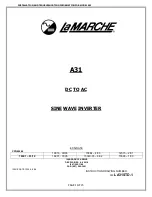
20
7.1.5
Charged detection time
This is the time the “Charged voltage” and “Tail current” must be met in order to consider the battery fully
charged.
Default setting
Range
Step size
3 minutes
0 – 100 minutes
1 minute
7.1.6
Peukert exponent
When unknown it is recommended to keep this value at 1.25 (default) for lead acid batteries and change to 1.05
for Li-ion batteries. A value of 1.00 disables the Peukert compensation. For more information see chapter 8:
“Battery capacity and Peukert exponent”
Default setting
Range
Step size
1.25
1.00 – 1.50
0.01
7.1.7
Charge efficiency factor
The “Charge Efficiency Factor” compensates for the capacity (Ah) losses during charging. A setting of 100%
means that there are no losses.
Default setting
Range
Step size
95%
50 – 100%
1%
The charge efficiency of a lead acid battery is almost 100% as long as no gas generation takes place. Gassing
means that part of the charge current is not transformed into chemical energy, which is stored in the plates of the
battery, but is used to decompose water into oxygen and hydrogen gas (highly explosive!). The energy stored in
the plates can be retrieved during the next discharge, whereas the energy used to decompose water is lost.
Gassing can easily be observed in flooded batteries. Please note that the ‘oxygen only’ end of the charge phase
of sealed (VRLA) gel and AGM batteries also results in a reduced charge efficiency.
A charge efficiency of 95% means that 10Ah must be transferred to the battery to get 9.5Ah actually stored in the
battery. The charge efficiency of a battery depends on battery type, age and usage. The SmartShunt takes this
phenomenon into account with the charge efficiency factor.
7.1.8
Current threshold
When the current measured falls below the “Current threshold” value it will be considered zero. The “Current
threshold” is used to cancel out very small currents that can negatively affect the long-term state of charge
readout in noisy environments. For example, if the actual long-term current is 0.0A and, due to injected noise or
small offsets, the battery monitor measures -0.05A the SmartShunt might, in the long term, incorrectly indicate
that the battery is empty or will need to be recharged. When the current threshold in this example is set to 0.1A,
the SmartShunt calculates with 0.0A so that errors are eliminated.
A value of 0.0A disables this function.
Default setting
Range
Step size
0.10A
0.00 – 2.00A
0.01A
7.1.9
Time-to-go averaging period
The time-to-go averaging period specifies the time window (in minutes) that the moving averaging filter works. A
value of 0 disables the filter and gives an instantaneous (real-time) readout. However, the displayed “Time
remaining” value may fluctuate heavily. Selecting the longest time, 12 minutes, will ensure that only long-term
load fluctuations are included in the “Time remaining” calculations.
Default setting
Range
Step size
3 minutes
0 – 12 minutes
1 minute
















































